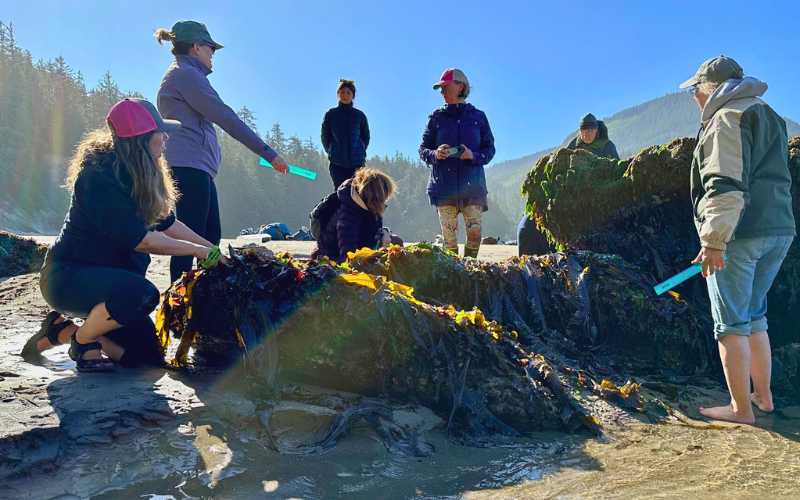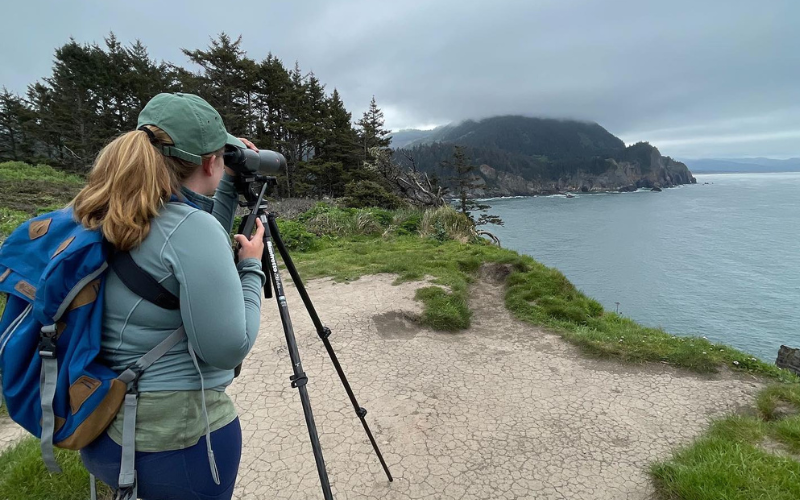
Jesse Jones (far left), with Oregon Shores CoastWatch, leads a sea star survey training at
Cape Falcon Marine Reserve in June 2023. Photo by Beth Wise
The Cape Falcon Marine Reserve, located offshore on the northern Oregon Coast, is often described as a living laboratory, a site for important scientific discovery.
However, that opportunity is not reserved for professional scientists who work for the Oregon Department of Fish & Wildlife or partnering agencies.
Community scientists can also get involved—and play a significant role in furthering our collective understanding of the ocean and the life it supports.
“It’s a way that people can actually get out into the marine reserve and see the issues that are happening in real-time and contribute to really important data collection for our different partner agencies,” NCLC Marine Program Coordinator Angela Whitlock says.
One of the important community science programs currently underway is sea-star surveying at the tidepools at Short Sand Beach, which is adjacent to Cape Falcon Marine Reserve. This is the second year Cape Falcon has served as a site for these surveys, which are used to provide data to the Multi-agency Rocky Intertidal Network (MARINe).
Jesse Jones, with Oregon Shores Conservation Coalition, led a training in June for volunteers. During the summer, they then go out independently during low tides to collect data on sea stars that is used to inform an understanding on how populations are faring after the sea start wasting disease in 2013.
Additionally, NCLC is holding a monthlong bioblitz at the marine reserve this summer to inventory the flora and fauna in this geographically defined area, Angela says. Anyone can participate by documenting their observations, and then this information illuminates what plant and animal species are showing up from year to year and if there are important trends.
“What’s cool about the bioblitz is it’s all about curiosity,” Angela says. “You don’t even have to know what you’re looking at.”
Participants can just share their photo for the project to iNaturalist, and others can help identify what species was observed.

Allison Anholt, a Coastal Community Science Biologist with Portland Audubon, scouts for black oystercatcher nests
at Cape Falcon Marine Reserve in May 2023.
Portland Audubon also does annual black oystercatcher (BLOY) monitoring at Cape Falcon Marine Reserve, where several pairs of these shorebirds nest.
“They are important because they literally rely on a healthy land-sea connection. They are completely dependent on the rocky intertidal environment,” Angela says. As an indicator species, “their presence in the rocky intertidal zone means the area is healthy and there is abundant food to support them and their chicks.”
Every year, community scientists also help document real-time observations for the King Tides Project, which helps local communities shape a picture of what the coast is going to look like in the future with sea-level rise and informs ocean-related initiatives and policies.
In the future, Angela also plans for the Marine Reserve Program of NCLC to participate in marine debris monitoring on the beach, and that’s another project that will require consistent volunteer support to take place year-round.
The best part of community science—besides it being a unique way to care for the environment—is that individuals don’t need to have a scientific pedigree or background. Trainings are provided and there are people available to answer questions and provide guidance.
“It’s very accessible to everybody and a great way to take part in issues that affect us,” Angela says. “We’re doing this to help support the larger picture up and down the Oregon Coast, with all the different partners and agencies that collect all that data to help shape the bigger picture.”
Comments